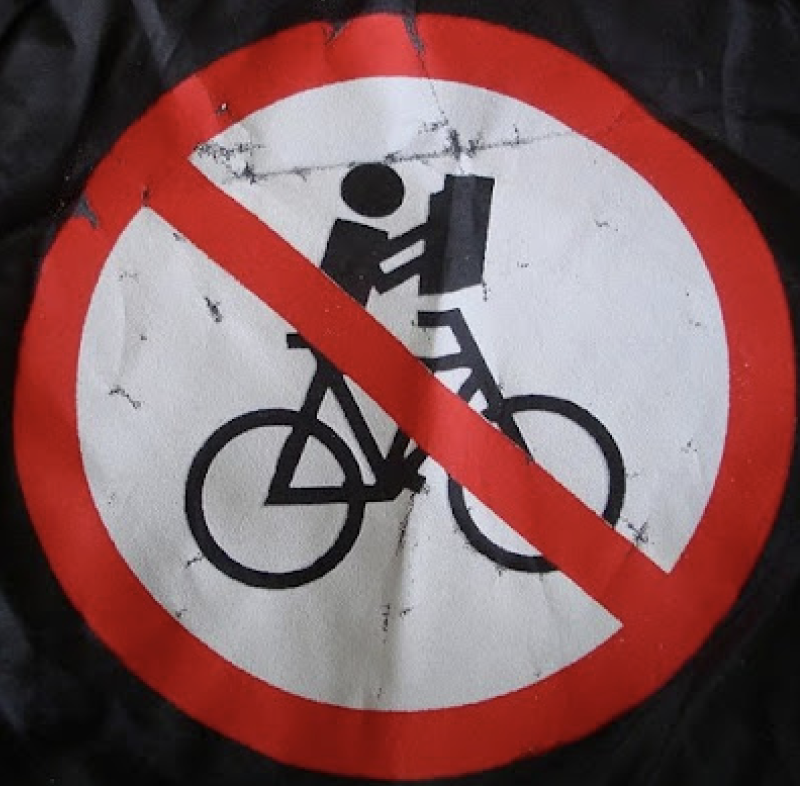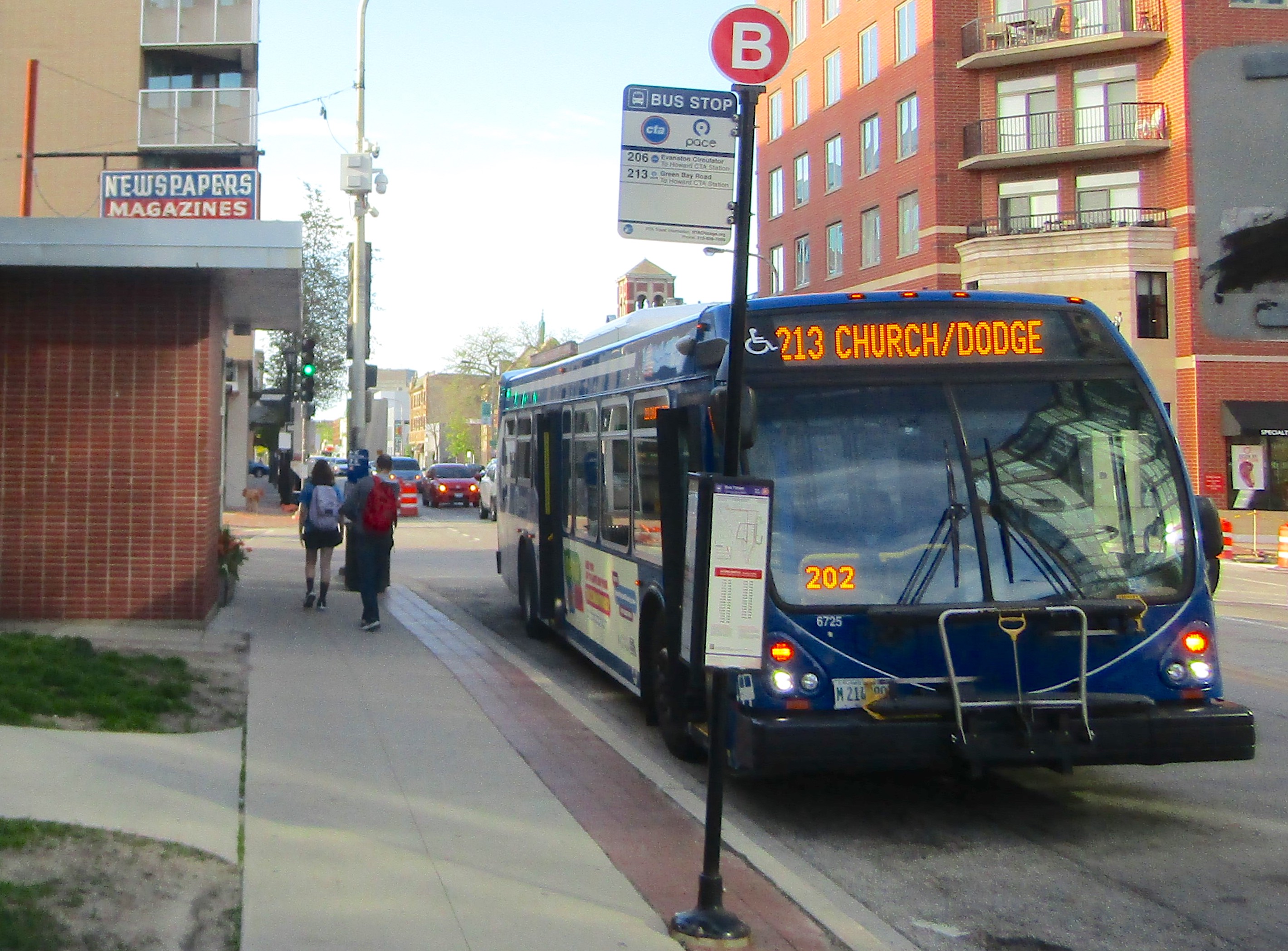Q & A: Why Does Catching the ‘L’ From O’Hare Cost $5, and Should I Use a Bike Bell?
11:20 PM CDT on March 24, 2019

The O’Hare Blue Line station. Photo: John Greenfield

This article is part of our new weekly Q & A feature, “The Chicago Transportation Authority,” presented by Keating Law offices. Send us a question that you want answered via email (jgreenfield[at]streetsblog.org) or a tweet (@streetsblogchi). You can also post a query in the comment section of this article or on our Facebook page.
Q: “Why does it cost $5 to ride the Blue Line from O’Hare instead of the usual $2.50?” – M.F.
The short answer is, in order to soak the tourists, and others who can afford air travel and therefore probably won’t be unduly burdened by the $2.50 surcharge. That helps keep the CTA affordable for everyone else. The $5 fare was originally implemented back in 2013, when the regular ‘L’ was $2.25.
“The additional fare for those traveling out of O’Hare is intended for the traveler market,” CTA spokesperson Irene Ferradaz told me. “Most U.S. transit agencies have an airport surcharge at their airport stations, and the CTA’s is among the lower fares.”
“This charge reflects the convenience and value of the ‘front door’ service the Blue Line provides, since it takes customers directly to the terminal,” Ferradaz added. “Even at $5, the cost of travel from O’Hare is an excellent value compared to all other vehicular options (taxi, ride hailing, shuttle buses) which can cost between $35 and $50.”
That’s not to mention Elon Musk’s O’Hare Express plan, which would supposedly whisk travelers from the airport in 16-person “electric sled” pods for $25, although mayoral candidates Lori Lightfoot and Toni Preckwinkle have indicated that they would kill the project if elected.
To make the $5 Blue Line fare more equitable, O’Hare workers don’t have to pay the surcharge. According to Ferradaz, they are able to get this discount by providing their Ventra transit account number to their employer, who submits it to Ventra, which then flags their account, so that they’re not charged the extra $2.50 at the turnstile on their way home from work.
Ferradaz said that the $2.50 O’Hare surcharge goes into the CTA’s general operating budget. She didn’t have figures for how much money the fee raises each year. But the O’Hare station saw about 3.93 million entries in 2017. If we suppose that say, a quarter of those entries were airport workers, that would come out to an extra $7.37 million that year in additional revenue for running the system. That’s nothing to sneeze at.

Q: “Is it socially acceptable to use a bike bell? I have used the bell on Divvy bikes when approaching a car leaving a parallel parking spot, or when passing a loading bus. But I feel a bike bell is a lot like a car horn - only to be used when immediate safety is at issue - not to announce your presence (I especially hate drivers who honk and screech out from an alley). Is it more polite to say "on your left" when passing a slower path user, or can I just ring a bell? Should I put a bell on my personal bike -- can a grown man use a bike bell?" -K.L.
First of all, yes a grown man can use a bike bell, have a front wicker basket, ride a step-through (“women’s”) frame, etc. – forget all the gendered and ageist nonsense you may have heard about what is or isn’t appropriate for your bike.
That said, bell etiquette, and the answer to the question of whether it’s more polite to ring a bell, call out “on your left,” or do nothing, when passing another rider is somewhat complex and subjective.
Bells are required gear for cycling in some countries, like Germany. And many people in nations where there’s tons of cycling and low crash and injury rates believe that the American obsession with bike helmet use is kind of silly, but would argue that you’d have to be nuts to ride a bike without a bell.
However, while bike bells have nowhere near the potential to cause aggravation and anger like car horns, it is possible to be rude with a bike bell. I remember riding home from Milwaukee on the Green Bay Trail with a friend at a good clip on a summer afternoon, when the path was fairly busy with pedestrians. My friend would dong his large, sonorous bell about 100 feet before we overtook people walking and jogging, and they always jumped out of the way, startled. It seemed a little inconsiderate to me, like he was ordering other trail users to get out of his way.
So I ran your question before a bunch of folks who regularly ride bikes. Of the dozens of people who responded, most said they prefer using bike bells to notify other road and path users of their presence instead of calling out a warning. Still there were a some people who favor a vocal warning, and couple of folks who feel it’s unnecessary to provide any warning before passing. Here’s a sample of some of the comments.
“I find using a bell on a path seems to work better than saying ‘on your left,’” said Blue City Cycles co-owner Owen Lloyd, “Also, sometimes ‘on you left’ comes across as being kinda mean-sounding.”
“I like bike bells,” said schoolteacher Jane Healy. “But I'm enough of a purist that I like using two bells: one soft and polite, the other loud and insistent. And I use my voice all the time.”
“Yes, bells, all the time,” said Boulevard Bikes owner Kevin Womac. “I hate riding a bike without a bell. It's a great way to say hi, especially to a fellow cyclist you may not know."
“I always start with the bell as a heads-up, especially since I know there is a lot of strong opposition to ‘on your left,’ said cyclist Cheryl Zalenski Falk. “But if the bell doesn't get the attention of the bicyclist or pedestrian, then I will say something, increasing volume if needed to get their attention. Drivers don't get the bell -- I just yell 'HEY!' at them, which so far has worked.”
“Bells for people, shout at cars!” seconded West Town Bikes director Alex Wilson.
“[Ringing a] bell is not as direct as my baritone voice announcing my intentions and thanking [other road or trail users] for their adherence,” dissented banker Elihu Blanks.
“Just yell,” agreed cyclist Mike Feirstein. “When you use a bell, the person doesn’t know which direction you’re coming from.
“I try to pass people with enough room so I don’t have to say anything,” said bike mechanic Mary Randall. “If that’s not possible I say ‘passing on your left’ in my best waitress voice. I’m not against bells but I don’t like being noisy. People out for a morning walk on the path are generally trying to find a peaceful place in the city and I try to respect that. I try to treat them as I want people in cars to treat me.”
But former Chicago Department of Transportation bike parking manager Eric Anderson argued that ringing a bike bell should never be construed as a negative thing. “The sound of bike bells is delightful. A happy city soundscape has bike bells...the sonic opposite of the angry, frustrated sound of honking cars.”
So there you have it. The majority of the folks I surveyed argued that ringing a bike bell is the best option to alert others to your presence when passing, and most feel it’s more polite than saying “on your left.” But you should use discretion so as not to startle people, and you might need to combine a bell ring with a vocal warning if the bell alone doesn’t catch people’s attention. So, yes, do bolt a bell on your personal bike’s handlebars and give it a ring.
This post is made possible by a grant from the Illinois Bicycle Lawyers at Keating Law Offices, P.C., a Chicago, Illinois law firm committed to representing pedestrians and cyclists. The content is Streetsblog Chicago's own, and Keating Law Offices neither endorses the content nor exercises any editorial control.
In addition to editing Streetsblog Chicago, John writes about transportation and other topics for additional local publications. A Chicagoan since 1989, he enjoys exploring the city on foot, bike, bus, and 'L' train.
Stay in touch
Sign up for our free newsletter
More from Streetsblog Chicago
Elevated Chicago’s new leader on how to build more support for equitable transit-oriented development
Recently announced as executive director Juan Sebastian Arias also shared his POV on Mayor Johnson's Cut the Tape initiative to speed up the development approval process
Since COVID, Pace ridership has fared better on major corridors and in north, northwest suburbs than in south, west ‘burbs
The suburban bus system's top five busiest routes largely maintained their ridership rankings.
Due to incredible support from readers like you, we’ve surpassed our 2023-24 fundraising goal
Once again, the generosity of walk/bike/transit boosters is fueling our reporting and advocacy.




